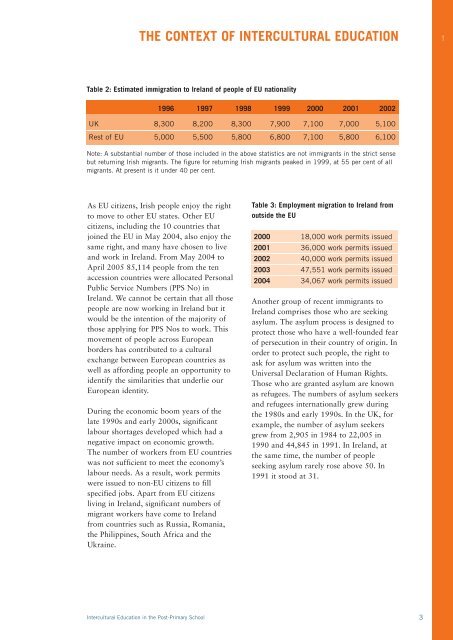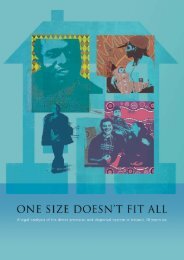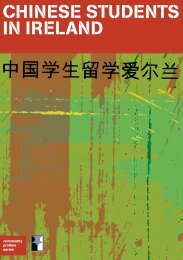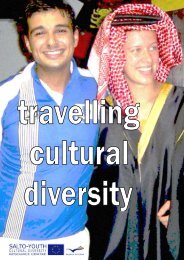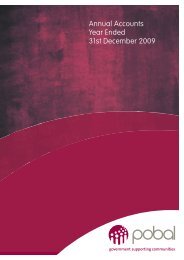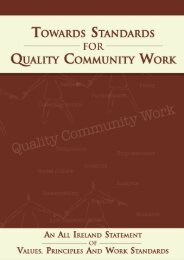Intercultural Education in the Post-Primary School - National Council ...
Intercultural Education in the Post-Primary School - National Council ...
Intercultural Education in the Post-Primary School - National Council ...
You also want an ePaper? Increase the reach of your titles
YUMPU automatically turns print PDFs into web optimized ePapers that Google loves.
THE CONTEXT OF INTERCULTURAL EDUCATION 1Table 2: Estimated immigration to Ireland of people of EU nationality1996 1997 1998 1999 2000 2001 2002UK 8,300 8,200 8,300 7,900 7,100 7,000 5,100Rest of EU 5,000 5,500 5,800 6,800 7,100 5,800 6,100Note: A substantial number of those <strong>in</strong>cluded <strong>in</strong> <strong>the</strong> above statistics are not immigrants <strong>in</strong> <strong>the</strong> strict sensebut return<strong>in</strong>g Irish migrants. The figure for return<strong>in</strong>g Irish migrants peaked <strong>in</strong> 1999, at 55 per cent of allmigrants. At present is it under 40 per cent.As EU citizens, Irish people enjoy <strong>the</strong> rightto move to o<strong>the</strong>r EU states. O<strong>the</strong>r EUcitizens, <strong>in</strong>clud<strong>in</strong>g <strong>the</strong> 10 countries thatjo<strong>in</strong>ed <strong>the</strong> EU <strong>in</strong> May 2004, also enjoy <strong>the</strong>same right, and many have chosen to liveand work <strong>in</strong> Ireland. From May 2004 toApril 2005 85,114 people from <strong>the</strong> tenaccession countries were allocated PersonalPublic Service Numbers (PPS No) <strong>in</strong>Ireland. We cannot be certa<strong>in</strong> that all thosepeople are now work<strong>in</strong>g <strong>in</strong> Ireland but itwould be <strong>the</strong> <strong>in</strong>tention of <strong>the</strong> majority ofthose apply<strong>in</strong>g for PPS Nos to work. Thismovement of people across Europeanborders has contributed to a culturalexchange between European countries aswell as afford<strong>in</strong>g people an opportunity toidentify <strong>the</strong> similarities that underlie ourEuropean identity.Dur<strong>in</strong>g <strong>the</strong> economic boom years of <strong>the</strong>late 1990s and early 2000s, significantlabour shortages developed which had anegative impact on economic growth.The number of workers from EU countrieswas not sufficient to meet <strong>the</strong> economy’slabour needs. As a result, work permitswere issued to non-EU citizens to fillspecified jobs. Apart from EU citizensliv<strong>in</strong>g <strong>in</strong> Ireland, significant numbers ofmigrant workers have come to Irelandfrom countries such as Russia, Romania,<strong>the</strong> Philipp<strong>in</strong>es, South Africa and <strong>the</strong>Ukra<strong>in</strong>e.Table 3: Employment migration to Ireland fromoutside <strong>the</strong> EU2000 18,000 work permits issued2001 36,000 work permits issued2002 40,000 work permits issued2003 47,551 work permits issued2004 34,067 work permits issuedAno<strong>the</strong>r group of recent immigrants toIreland comprises those who are seek<strong>in</strong>gasylum. The asylum process is designed toprotect those who have a well-founded fearof persecution <strong>in</strong> <strong>the</strong>ir country of orig<strong>in</strong>. Inorder to protect such people, <strong>the</strong> right toask for asylum was written <strong>in</strong>to <strong>the</strong>Universal Declaration of Human Rights.Those who are granted asylum are knownas refugees. The numbers of asylum seekersand refugees <strong>in</strong>ternationally grew dur<strong>in</strong>g<strong>the</strong> 1980s and early 1990s. In <strong>the</strong> UK, forexample, <strong>the</strong> number of asylum seekersgrew from 2,905 <strong>in</strong> 1984 to 22,005 <strong>in</strong>1990 and 44,845 <strong>in</strong> 1991. In Ireland, at<strong>the</strong> same time, <strong>the</strong> number of peopleseek<strong>in</strong>g asylum rarely rose above 50. In1991 it stood at 31.<strong>Intercultural</strong> <strong>Education</strong> <strong>in</strong> <strong>the</strong> <strong>Post</strong>-<strong>Primary</strong> <strong>School</strong> 3


